Most professionals are always connected. Knowledge workers are used to collaborating on objects in the cloud: they alternate their laptop, tablet, or mobile phone, to work concurrently on the same version of the document, spreadsheet, presentation, article, web design, software code, prototype, etc. No need to download, install, send, merging changes, etc. All of them working together on the same version of the truth.
Complex things do not come out right at the first try. Subject matter expert productive collaboration is needed, but they should focus on what it is important. Managing cloud objects would increase work productivity and quality exponentially. In the project economy, it is also time to digitize management, knowledge and interactions between people working on projects, programs, and portfolios.
Objects in the Cloud for Knowledge Workers
Let’s say a group of experts have to write a document. Since they all have a stable internet connection, they decide to use Google Docs. Each expert is able to review the whole document and write their part, tracking changes, anytime, anywhere, asynchronously. They can do everything with their mobile phones. The document link can be shared with other experts who can access to read, change o suggest changes.

When they are done, they can save it as a Word document in a shared folder in Google Drive to make a professional copy writer format headers, footers, table of contents, indexes, tables, charts, etc. SMEs can review the last version opening the link, but they can also review previous versions. No need of sending any file, making copies, or merging changes.
Tools can optimize management for objects in the cloud, saving much time for knowledge workers, allowing them to collaborate effectively and focus on value tasks. Quality can improve continuously with successive, immediate object refinements, practically with no cost.
Now let’s imagine other objects, more complex than a document, such as a web design, or a software application. Many teams use figma for editing and sharing design in the cloud, balsamiq to share functional mockups, etc. Software development teams use cloud repositories like GitHub, or GitLab.
Tools for managing objects in the cloud are so mature, that some job platforms have flourished to industrialize knowledge workers jobs. Nowadays, it is quite usual hiring programmers and designers at upwork, toptal, freelancer, fiverr, behance, dribbble, 99designs, etc. Programmers and designers make good money just working at these platforms.

Managing Projects in the Cloud
The project economy empowers self-organizing, horizontal, democratic, consensus driven teams. These teams need to engage more and more stakeholders to focus on real value and proactive decision making.
In the project economy, collaboration with stakeholders should be inclusive, frequent, proactive, with more and more people monitoring the same project. The proper technology here is the mobile phone, but people do not usually read documents on the phone. The model for managing projects in the cloud professionally should not only be informational –document based– but transactional: that is, based on objects that users can read, update, create and delete from their computer, tablet, or mobile phone. For example: an assignment, a time sheet, an expense, a milestone, a baseline start/duration/finish/cost, a risk, a status report, a change, a comment, a feedback, etc.
Projects in the cloud should use transactional –not informational– objects.
Objects to manage projects professionally in the cloud are not just project documents. Managing by documents is good for compliance, but is no good to anticipate problems, meeting goals, or delivering value.
Many projects must produce a documentary dossier to meet compliance requirements. Many project managers produce these document artifacts progressively and use them to manage the project.
Project management by documents hinder value driven approach.
Since documentation is often seen as a bureaucratic burden, documenting is not effective in management collaboration. Management artifacts must be value-oriented and target the right people. If the collaboration between people is registered in shared objects, it should be always possible to automate the generation of the documentary dossier when the project is closed.
Objects to manage Projects in the Cloud
Objects to manage projects, programs, and portfolios professionally should be designed having in mind there are three key elements in professional project management:
- decomposition
- frequent status reports
- people working under an extended team using collaborative roles
People can use roles to collaborate on projects from the side of demand management, or the side of supply management:
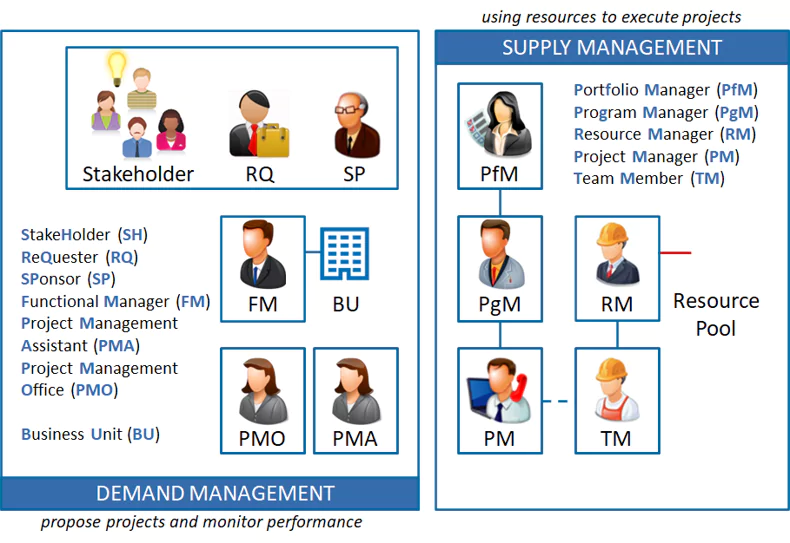
Work packages, defined as the lowest level of the project work breakdown structure, for which cost and duration can be estimated and managed, are the central objects to organize project management professional collaboration in the cloud:
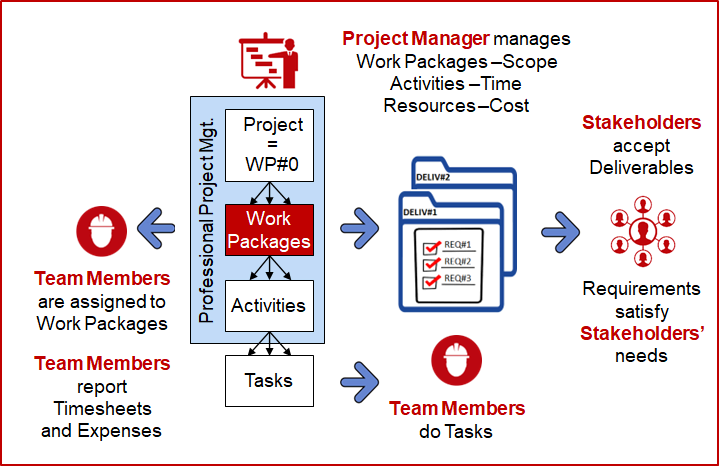
Projects can be organized in business units, programs, and portfolios. Let’s set a simple example of an organization with 8 projects running in 3 business units, some of them are managed as components of 2 programs, and 2 portfolios.
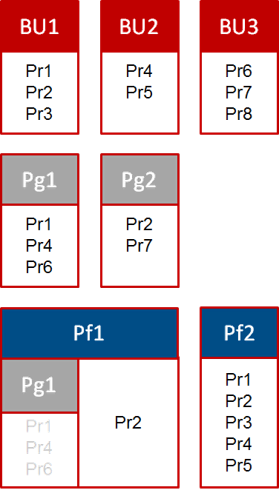
Projects #1, #4 and #6 are managed inside program #1, and projects #2 and #7 belong to program #2. Projects #3, #5 and #8 do not belong to any program. Projects #3 and #5 belong to portfolio #2, and projects #1, #2 and #4 belong to both portfolios #1 and #2. Projects #7 and #8 do not belong to any portfolio. Program #1 is included in portfolio #1.
On the other hand, projects may have a procurement relationship. Let’s say project #1 is broken down into 6 work packages, and the last one is managed also as a project #2 by other organization, business unit, or other team of the same business unit. If this procurement relationship is modeled as objects in cloud, project managers of the two projects can interact productively:

People collaborating on projects, programs, and portfolios can read, create, update, and delete different objects. The following table shows some objects managed inside our tool PMPeople. For instance, a project status report can be created, updated, or deleted by users with any of the following roles: PMO, project manager assistant, portfolio manager, program manager and project manager.
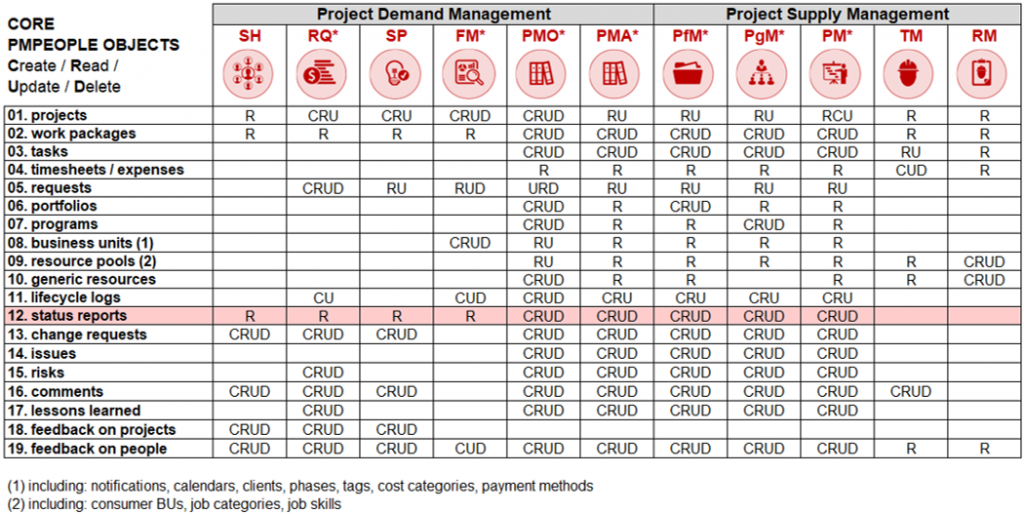
Value driven requires more and more stakeholders sharing great number of technical objects –terms and conditions. resources. job descriptions. SOW, specifications, documents, blueprints, test cases, releases, defects, etc.– and management objects –procurements, payments, funding events, milestone dates, activity start/finish dates, baseline/planned/actual dates, activity dependencies, budgets, cost estimates, actual costs, team member assignations, time sheets, expense sheets, corrective actions, defects, audit nonconformance issues, change requests, comments, feedbacks, surveys, dashboard indicators, status reports, forecasts, scope statement, requirements, deliverables, project charter, stakeholders, risks, issues, assumptions, lessons learned, etc.
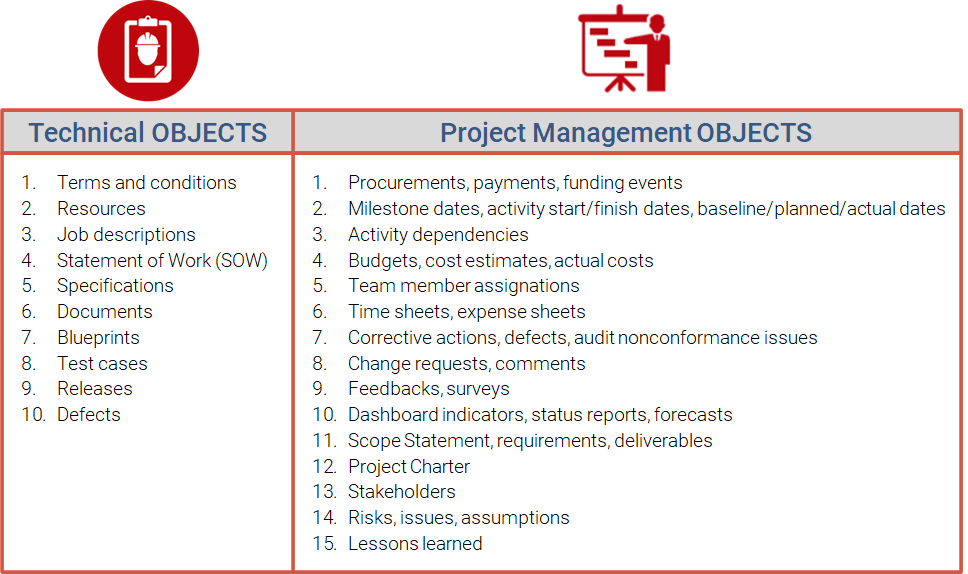
Every day there are more and more projects needing quick effective decision making from a big number of decentralized active stakeholders who can share and access big amounts of data, from any device, everywhere, anytime. We can see a trend in project management “socialization” producing more and more project related data.
PMPeople is the tool for the project economy. It is aimed to unify professional project management by these differential points:
- Designed by and for professional project managers, following professional project management standards.
- Online productivity –less meetings, less documents, less workflows– through distributed collaboration among 12 specialized roles: Organization Owner, 6 roles on demand management and 5 roles on supply management.
- Freemium product –unlimited time, unlimited users– usable via web and mobile application.
Start using PMPeople for free, for unlimited time and for any number of users. In premium organizations, only managers have a cost. Several roles –stakeholders, team members, sponsors and resource managers– are always free. You can increase, or decrease your premium seats according to the organization actual needs. Premium organizations have access to our interactive support through Slack. Our servers are located in EU. This software can also be hosted on customer premises.
Jose Barato
Related posts
Categories
- Business (16)
- Demand Management Roles (14)
- Frequently Asked Questions (7)
- Guide (26)
- People (23)
- Assignments (2)
- Feedback (2)
- Project Team (3)
- Tracking Time And Expenses (2)
- Process (9)
- Closing (2)
- Executing And Controlling (2)
- Planning (1)
- Project Management (67)
- Management Frameworks (18)
- Organization Owner (OO) (3)
- Project Economy (54)
- Tools (19)
- Supply Management Roles (5)
- Training (6)
- Uncategorized (1)





